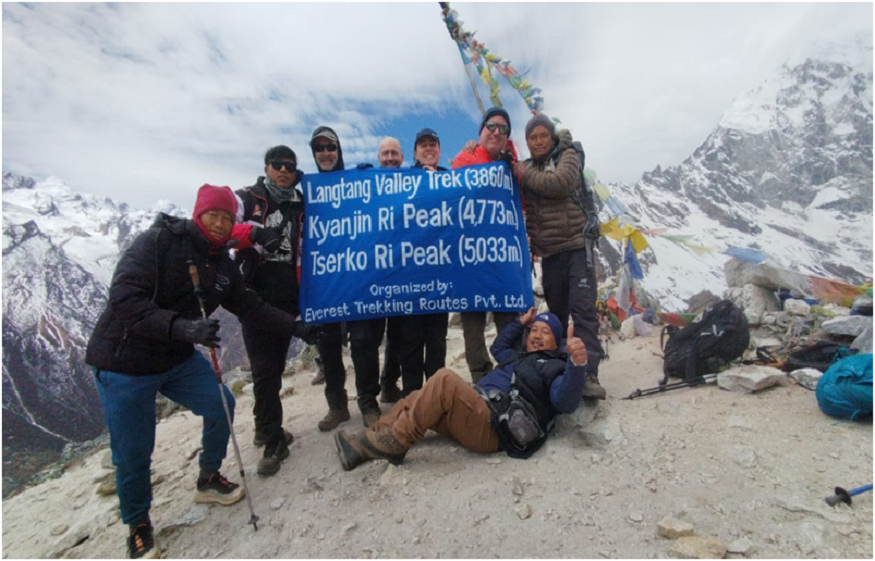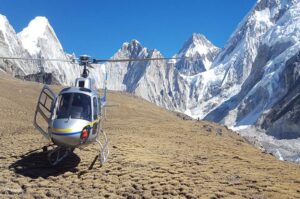In the world of mountain trekking, few places compare to Nepal. It’s a nation where old trails weave through good country towns, supplication banners move in the wind, and the peaks penetrate the sky like solidified titans. Home to eight of the world’s most noteworthy mountains, Nepal isn’t a fair goal — it’s a dream for trekkers around the globe. The combination of sensational scenes and otherworldly profundity makes an encounter that rises above the physical trek.
Among the numerous courses crisscrossing the Himalayas, four stand out for their history, differing qualities, and exceptional magnificence: the Annapurna Base Camp trek, the Langtang Valley trek, the Manaslu Circuit trek, and the Everest Three Pass trek. These treks each exhibit a special viewpoint of Nepal’s topography and culture, advertising something for each traveler — whether it’s awe-inspiring sights, wealthy legacy, or crude experience. Together, they speak to the apex of Himalayan trekking.
Annapurna Base Camp trek
The Annapurna Base Camp trek is one of the most well known treks in Nepal — and for great reason. It offers an amazing combination of mountain magnificence, social interaction, and availability. Beginning from the bustling visitor city of Pokhara, the trek rapidly clears out behind civilization and jumps into a world of rich timberlands, cascading waterfalls, and terraced hillsides.
This travel winds through a few dynamic Gurung and Magar towns such as Ghandruk, Chhomrong, and Bamboo, where trekkers are invited with warm grins and conventional neighborliness. The path takes after the Modi Khola Waterway, rising steadily through rhododendron and bamboo woodlands, some time recently climbing into the snow capped zone.
As explorers rise, the path opens into the Annapurna Asylum, an icy mass bowl ringed by a few of the Himalayas’ most famous peaks: Annapurna I (8,091 m), Machapuchare (6,993 m) — the sacrosanct “Fishtail” Mountain — Hiunchuli, and Gangapurna. The last goal, Annapurna Base Camp at 4,130 meters, conveys an unmatched 360-degree scene of snow-capped majesty.
The trek ordinarily takes 7 to 12 days, depending on the chosen course and pace. With well-established teahouses and direct trouble, it suits both first-time trekkers and experienced explorers. It’s a way that equalizes challenge with tranquility, and offers a glorious presentation to the Himalayas.
Langtang Valley trek
To those who long for a calmer, more intelligent encounter in the mountains, the Langtang Valley trek offers isolation, the most profound sense of being, and dazzling view — all fair a brief separate north of Kathmandu. In spite of the fact that it is not as well-known as Annapurna or Everest, Langtang holds an extraordinary charm that waits long after the trek is over.
The path starts with a drive to Syabrubesi, a little town settled at the foot of the Langtang Himal. From here, trekkers take after the Langtang Khola Waterway through thick woodlands of pine and rhododendron, steadily climbing toward snow capped glades and glacier-fed streams. Natural life is plentiful in this region; if fortunate, trekkers may spot ruddy pandas, Himalayan monals, or indeed musk deer in the forest.
Along the way, the way passes through socially wealthy towns like Lama Lodging, Langtang Town, and at last Kyanjin Gompa, an excellent settlement at 3,870 meters with a memorable Buddhist cloister and yak cheese production line. Kyanjin Ri (4,773 m) and Tserko Ri (4,984 m) are discretionary side climbs that compensate those who climb them with clearing sees of Langtang Lirung, Yala peak, and the gleaming icy masses below.
The Langtang Valley trek as a rule takes 7 to 10 days and is culminated for trekkers who need a brief but satisfying Himalayan travel with both social and beautiful profundity. After the 2015 seismic tremor, the region has gradually revamped and presently invites guests enthusiastically to offer assistance to revitalize the neighborhood economy. It is a calm diamond that merits its placing among Nepal’s finest trekking experiences.
Manaslu Circuit trek
For the genuine globe-trotter, the Manaslu Circuit trek offers a crude and invigorating entry through Nepal’s farther northern wilderness. Circling Mount Manaslu (8,163 m) — the eighth most elevated mountain in the world — this trek leads through separated valleys, old Buddhist towns, and rough elevated wilderness.
The trip starts at Soti Khola and takes after the sensational course of the Budhi Gandaki Waterway, carving through profound gorges and cliffs. The lower segments of the trek are lavish and tropical, with rice areas and cascading waterfalls. As the path climbs, the scene shifts to pine woodlands, high pasturelands, and inevitably desolate, wind-blasted plateaus.
Villages like Namrung, Lho, Sama Gaun, and Samdo uncover a special mix of Nepali and Tibetan legacy. Supplication wheels turn in the wind, stone stupas stamp the ways, and centuries-old religious communities neglect the valleys. Trekkers have the chance to investigate Pungen Gompa, settled underneath the taking off dividers of Manaslu itself.
The climax of the trek is the crossing of Larkya La Pass (5,106 m) — a cold, high-altitude saddle with jaw-dropping views of Himlung, Cheo Himal, and indeed Annapurna II. The plunge into the Marsyangdi Valley marks the trek’s conclusion, returning trekkers to more populated terrain.
The full trek ordinarily takes 14 to 18 days, and since it lies in a confined region, an extraordinary permit and an authorized direct are required. The Manaslu Circuit is less commercialized than Annapurna or Everest and is perfect for those who need farther wild, rough trails, and a more profound association to both arrive and people.
Everest Three Pass trek
At the best of each trekker’s dream list stands Everest — and for those who need more than the conventional base camp encounter, the Everest Three Pass trek offers the extreme Himalayan challenge. It’s a high-altitude circuit that tests perseverance, but too gives the most comprehensive investigation of the Khumbu region — the sacrosanct heartland of the Sherpa individuals and domestic of the world’s highest mountain.
The enterprise starts in Lukla, taking after the renowned worldwide Everest path through Phakding and Namche Bazaar, the Sherpa capital. From here, the travel wanders from the classic course and digs into the high mountain passes that characterize this trek: Kongma La (5,535 m), Cho La (5,420 m), and Renjo La (5,360 m).
These passes are not fair physical obstacles — they are portals to the most marvelous vistas in the Himalayas. The path winds past Everest Base Camp (5,364 m), climbs Kala Patthar (5,545 m) for dawn views of Everest, and comes to the shining turquoise waters of the Gokyo Lakes. Trekkers visit sacrosanct cloisters in Tengboche, rough good country settlements like Thame, and lesser-visited trails where the isolation is coordinated as it were by the magnificence of the peaks above.
The Everest Three Pass trek ordinarily takes 18 to 21 days, and is considered one of the most challenging teahouse treks in Nepal due to its height, remoteness, and requesting risings. However for those who total it, it gets to be the travel of a lifetime — a trek that not as it were overcomes passes, but too fears, boundaries, and limits.
Culture, Nature, and the Soul of the Himalayas
What makes these four treks really extraordinary is not the scale of the mountains, but the profundity of the encounter. Along the trails, trekkers experience a wide range of societies — Gurung, Magar, Tamang, Sherpa, and Tibetan — each with their claimed traditions, celebrations, clothing, and beliefs. Buddhist religious communities roosted on cliffs, colorful supplication banners fluttering in the wind, and the ever-present sound of yak chimes ended up a portion of the beat of the trek.
The characteristic differing qualities is similarly surprising. From subtropical woodlands and terraced areas to snow capped deserts and cold bowls, the view always advances. On a single trek, you might walk through sprouting rhododendron woodlands, cross frosty streams on suspension bridges, climb rough passes secured in snow, and stand underneath the towering faces of 8,000-meter giants.
The Himalayas too offer minutes of hush and otherworldly existence that go distant past touring. Whether contemplating adjacent to a chorten in Langtang, sharing butter tea with ministers in Manaslu, or observing first light break over Everest, trekkers frequently depict these encounters as life-changing. The straightforwardness of life on the path — where your greatest concerns are your following step, the another feast, and the following dawn — brings clarity and peace.
Practical Exhortation for Trying Trekkers
To really appreciate these Himalayan experiences, a few arrangements are basic. Spring (Walk to May) and harvest time (September to November) are the perfect trekking seasons, advertising clear skies, comfortable temperatures, and steady weather.
Trekkers ought to be in great physical condition, particularly for higher height courses like Manaslu and Everest Three Passes, which include soak climbs and require acclimatization. Enlisting nearby guides and watchmen not as it were gives back and security but too contributes to the nearby economy and extends social interaction.
Most treks are bolstered by an organization of teahouses, which offer suppers, lodging, and community air. Normal nourishment incorporates dal bhat (lentils and rice), noodles, Tibetan bread, vegetable curries, and unending mugs of tea. Whereas comfortable, these are essential housing — portion of what makes trekking in Nepal so refreshingly authentic.
Permits shift by region and must be gotten in advance:
- Annapurna and Langtang: TIMS card and preservation range permit.
- Manaslu: Confined Zone Allow, MCAP, and ACAP.
- Everest: Khumbu Region Allow and Sagarmatha National park Permit.
Conclusion:
Trekking in Nepal is more than an open air enterprise — it’s a trek into a living, breathing world where mountains are divine beings, trails are conventions, and outsiders end up companions. The Annapurna Base Camp, Langtang Valley, Manaslu Circuit, and Everest Three Pass treks each offer their claim enchantment, and together, they make a representation of a country soaks in characteristic excellence and human warmth.
For each step taken on these trails, the mountains allow something in return — quality, stillness, amazement, and change. This is why individuals return to Nepal once more and once more. The ways may alter, but the drag of the Himalayas remains eternal.
So if you dream of standing underneath the world’s most elevated peaks, of breathing in fresh mountain discussions, and of strolling trails that lead not fair over arrive but into the heart — Nepal is calling. And these four treks are holding up to appear you the way.
Contact Details
Company address: Everest Trekking Routes Pvt. Ltd.
16 Khumbu, Nayabazaar, Kathmandu, Nepal
Mobile : +977-9843467921 (Rabin)
Email: [email protected]



